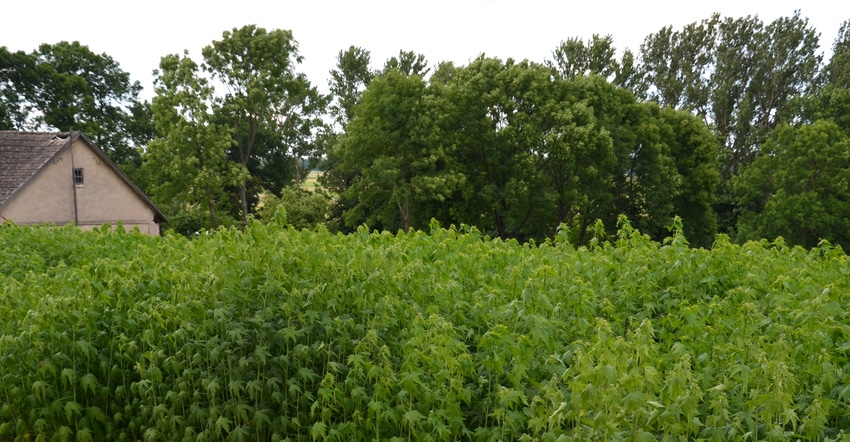July 5, 2019

The 2018 Farm Bill provided a pathway for industrial hemp to become a legal, viable crop in the U.S.
Further legislation passed by the Nebraska Legislature and approved by the governor May 30 established the Nebraska Hemp Farming Act and instructed the Nebraska Department of Agriculture to develop regulations for the legal cultivation and utilization of industrial hemp in the state.
But with both moves, there still are several questions as to the market potential and the regulatory oversight of hemp production and possibilities.
While hemp was an established, historical crop desired for fiber usage before and during World War II, it lost favor and standing as anti-marijuana regulations expanded over time. The Controlled Substances Act of 1970 ushered in the prohibition of hemp, even though industrial hemp and marijuana were recognized as distinct varieties of the cannabis plant.
Industrial hemp is specifically defined as the plant Cannabis sativa L., or any part of it with a delta-9 tetrahydrocannabinol concentration of not more than 0.3% on a dry weight basis. (THC is the psychoactive component in the prohibited cannabis variety marijuana.)
Although industrial hemp has been an accepted agricultural commodity in Canada, across Europe and in many other countries around the globe, it was prohibited in the U.S. because of its inclusion on the federal list of controlled substances.
While a few states started to allow industrial hemp production in recent years, the 2014 Farm Bill provided the first federal authority for legal cultivation of hemp in the U.S., but then only as a pilot program for research.
Kentucky has been a leader in hemp research and production efforts so far, and it was Senate Majority Leader Mitch McConnell of Kentucky that championed the expanded hemp opportunities included in the 2018 Farm Bill.
The 2018 Farm Bill specifically removed industrial hemp from the list of controlled substances and facilitated interstate commerce of industrial hemp products, thereby removing the direct prohibition on production and marketing of industrial hemp.
But it didn’t specifically legalize production or preempt existing state prohibitions. Instead, it established a basis for developing federal guidelines for state or tribal plans to regulate the legal production and marketing of industrial hemp. USDA’s Agricultural Marketing Service is responsible for the development of those rules, which aren’t expected before later this year.
More than 40 states already have enacted legislation to allow commercial or research cultivation of industrial hemp, including Nebraska. The legislation in Nebraska specifically called for the development of a state plan to be submitted to USDA and allowed for the operation of a pilot program under the framework of the existing 2014 Farm Bill authority.
The Nebraska Department of Agriculture announced a short application window in late June for licenses for 2019 production and processing under the existing framework, but still must develop broader production, processing and marketing regulations that are submitted and approved by USDA under the still-to-be-published federal guidelines.
While the specific legal pathway ahead for industrial hemp in Nebraska still is in development, there already is widespread interest in the new crop and new opportunities. Industrial hemp effectively produces three different products, including fiber for textiles or biomass; seed for oil, feed or food; and cannabidiol (CBD) extracted from the resin in the plant’s flowers.
The production and market potential for each is an important consideration for anyone thinking about industrial hemp as a new crop.
The potential to turn the plant’s fiber into textiles or bioenergy is not novel or uncertain. With global production already in place, there should be a basic commodity value that can be assessed, although the value could vary substantially based on where processing or utilization may be located, similar to other commodities with isolated processing facilities (such as sunflowers).
From the seed, the feed value also may be readily measured, but the food value of the seed or the oil likely depends on further value-added marketing or development. Certain compositional and nutritional characteristics of hemp seed or oil may generally be known, but generating value from them seems to be reliant on the entrepreneur’s marketing skills more than their production skills.
CBD (or CBD oil, as it is commonly referred) is grabbing the biggest headlines of the day, but also seems to have the most uncertainty as it is marketed for various purposes and with varying promises as a homeopathic remedy. While there is growing research underway, there are few specific documented or verifiable label claims about either hemp seed, oil or CBD.
For the producer, industrial hemp looks like a promising and now legal option to consider adding to the crop mix. However, given the different products and markets and the different risks associated with production, it still will be a challenging decision for producers.
Beyond basic production costs, equipment needs and risks associated with growing the unique crop, producers face a combined production and legal risk if weather or production conditions cause variation in the level of THC in the hemp and raise it above the accepted maximum of 0.3%.
At that point, the industrial hemp would become an illegal cannabis crop and would need to be destroyed. Industrial hemp producers also continue to face political risk from other interests that would prefer to cloud the distinction between industrial hemp and marijuana as part of separate efforts to further decriminalize that product.
The 2018 Farm Bill helps pave the way for viable industrial hemp production, including the inclusion of industrial hemp as an insurable commodity under the Whole Farm Revenue Protection policy beginning in 2020, although developing hemp-specific coverage and the appropriate production histories and ratings will take time.
Further research, development and education on production, processing and manufacturing also will help answer many unknown questions at present, but challenges will remain for any producer willing to consider and adopt the new crop in the coming years.
Lubben is an Extension policy specialist at the University of Nebraska-Lincoln.
About the Author(s)
You May Also Like






